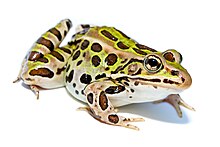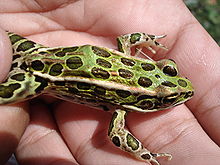Northern leopard frog
| Northern leopard frog | |
|---|---|

| |
| Scientific classification | |
| Domain: | Eukaryota |
| Kingdom: | Animalia |
| Phylum: | Chordata |
| Class: | Amphibia |
| Order: | Anura |
| Family: | Ranidae |
| Genus: | Lithobates |
| Species: | L. pipiens
|
| Binomial name | |
| Lithobates pipiens (Schreber, 1782)
| |

| |
| Range of L. pipiens | |
Lithobates pipiens[1][2][3][4] formerly Rana pipiens,[5][6] commonly known as the northern leopard frog, is a species of leopard frog from the true frog family, native to parts of Canada and the United States. It is the state amphibian of Minnesota and Vermont.
Description

The northern leopard frog is a fairly large species of frog, reaching about 11 cm (4.3 in) in snout-to-vent length. It varies from green to brown in
Tadpoles are dark brown or grey, with light blotches on the underside. The tail is pale tan.
Color variations


The northern leopard frog has several different color variations, with the most common two being the green and the brown morphs, with another morph known as the burnsi morph. Individuals with the burnsi morph coloration lack spots on their backs, but may or may not retain them on their legs. They can be bright green or brown and have yellow dorsal folds.[8] Albinism also appears in this species, but is very rare. They can also be blue, and this is quite rare also[9].
Ecology and behavior

Northern leopard frogs have a wide range of habitats. They are found in permanent ponds, swamps, marshes, and slow-moving streams throughout forest, open, and urban areas.
This species was once quite common through parts of western Canada and the United States until declines started occurring during the 1970s. Although the definitive cause of this decline is unknown, habitat loss and fragmentation, environmental contaminants, introduced fish, drought, and disease have been proposed as mechanisms of decline and are likely preventing species' recovery in many areas.[7] Many populations of northern leopard frogs have not yet recovered from these declines.
Northern leopard frogs are preyed upon by many different animals, such as snakes, raccoons, other frogs, and even humans. They do not produce distasteful skin secretions and rely on speed to evade predation.
They eat a wide variety of animals, including crickets, flies, worms, and smaller frogs. Using their large mouths, they can even swallow birds and garter snakes. In one case, a bat was recorded as prey of this frog.[11] This species is similar to the pickerel frog (Lithobates palustris) and the southern leopard frog (Lithobates sphenocephalus).
Research
Medical
The northern leopard frog produces specific
Neuroscience
The northern leopard frog has been a preferred species for making discoveries about basic properties of
Muscle physiology and biomechanics
The northern leopard frog is a popular species for in vitro experiments in muscle physiology and biomechanics due to the ease of accessibility for investigators in its native range and the ability of the sartorius muscle to stay alive in vitro for several hours. Furthermore, the reliance of the frog on two major modes of locomotion (jumping and swimming) allows for understanding how muscle properties contribute to organismal performance in each of these modes.
Range
Northern leopard frogs occur from Great Slave Lake and Hudson Bay, Canada, south to Kentucky and New Mexico, USA.[20][21] It is also found in Panama, where it is endemic to the central cordillera and western Pacific lowlands, although this is most likely an undescribed species.[1] They occupy grasslands, lakeshores, and marshes.
See also
- Southern leopard frog
- Plains leopard frog
- Rio Grande leopard frog
- Lowland leopard frog
- Relict leopard frog
- American bullfrog
- Pickerel frog
References
- ^ a b c IUCN SSC Amphibian Specialist Group (2022). "Lithobates pipiens". IUCN Red List of Threatened Species. 2022: e.T79079800A3072377. Retrieved 14 December 2022.
- Frost, Darrel (2011). "American Museum of Natural History: Amphibian Species of the World 5.5, an Online Reference". Herpetology. The American Museum of Natural History. Retrieved 2013-02-17.
- S2CID 55147982.
- ^ Integrated Taxonomic Information System [Internet] 2012. Lithobates pipiens [updated 2012 Sept; cited 2012 Dec 26] Available from: www.itis.gov/
- ^ Hillis & Wilcox (2005), Hillis (2007), Stuart (2008), Pauly et al. (2009), AmphibiaWeb (2016)
- PMID 27288482.
- ^ a b Northern Leopard Frog Rana pipiens, National Geographic. Retrieved 2015-03-28
- ^ "Northern Leopard Frog Rana pipens". HerpNet. Retrieved 2013-10-30.
- ^ https://www.nbcrightnow.com/news/rare-blue-northern-leopard-frog-found-in-grant-county/article_02345ac6-2911-11ef-970f-87e4e4a74e5e.html
- ^ Northern Leopard Frog (Lithobates pipiens), Nevada Fish and Wildlife Office. Retrieved 2015-03-28.
- .
- ^ Frog molecule could provide drug treatment for brain tumors
- PMID 14946732.
- PMID 13175199.
- S2CID 8739509.
- S2CID 8663912.
- PMID 171380.
- PMID 6033586.
- PMID 4543940.
- ^ Stebbins, R.C. (1985). A Field Guide to Western Reptiles and Amphibians. Second Edition. Houghton Mifflin Company, Boston, Massachusetts.
- ^ Conant, R. and Collins, J.T. (1991). A Field Guide to Reptiles and Amphibians: Eastern and Central North America. Third Edition. Houghton Mifflin Company, Boston, Massachusetts.
Further reading
- AmphibiaWeb, available at http://amphibiaweb.org/
- Ankley GT, Tietge JE, DeFoe DL, Jensen KM, Holcombe GW, Durhan EJ, Diamond SA. (1998). "Effects of ultraviolet light and methoprene on survival and development of Rana pipiens ". Environmental Toxicology and Chemistry 17 (12): 2530-2542. (abstract)*JSTOR 2097147.
- Hillis, D. M. (2007). "Constraints in naming parts of the Tree of Life" (PDF). PMID 16997582. Archived from the original(PDF) on 2011-09-27. Retrieved 2016-07-09.
- Hillis, David M.; Frost, John S.; Wright, David A. (1983). "Phylogeny and Biogeography of the Rana pipiens Complex: A Biochemical Evaluation". Systematic Zoology. 32 (2): 132–43. JSTOR 2413277.
- Hillis, D. M.; Wilcox, T. P. (2005). "Phylogeny of the New World true frogs (Rana)". PMID 15619443.
- Pauly, Greg B.; Hillis, David M.; Cannatella, David C. (2009). "Taxonomic freedom and the role of official lists of species names" (PDF). Herpetologica. 65 (2): 115–128. S2CID 283839. Archived from the original(PDF) on 2011-07-26.
- Schreber JCD von. (1782). "Beytrag zur Naturgeschichte der Frösche ". Der Naturforscher, Halle 18: 182-193. (Rana pipiens, new species). (in German).
- Stuart, Bryan L (2008). "The phylogenetic problem of Huia (Amphibia: Ranidae)". PMID 18042407.
- Yuan, Z.-Y.; Zhou, W.-W.; Chen, X.; Poyarkov, N. A.; Chen, H.-M.; Jang-Liaw, N.-H.; Chou, W.-H.; Iizuka, K.; Min, M.-S.; Kuzmin, S. L.; Zhang, Y.-P.; Cannatella, D. C.; Hillis, D. M.; Che, J. (2016). "Spatiotemporal diversification of the true frogs (genus Rana): A historical framework for a widely studied group of model organisms". Systematic Biology. 65 (5): 824–42. PMID 27288482.
External links
 Data related to Lithobates pipiens at Wikispecies
Data related to Lithobates pipiens at Wikispecies Media related to Lithobates pipiens at Wikimedia Commons
Media related to Lithobates pipiens at Wikimedia Commons- Northern Leopard Frog (Rana pipiens) — Natural Resources Canada.
- AWD: Rana pipiens — animal diversity, University of Michigan.
- BBC news: "Rana pipiens and the treatment of brain tumours."

